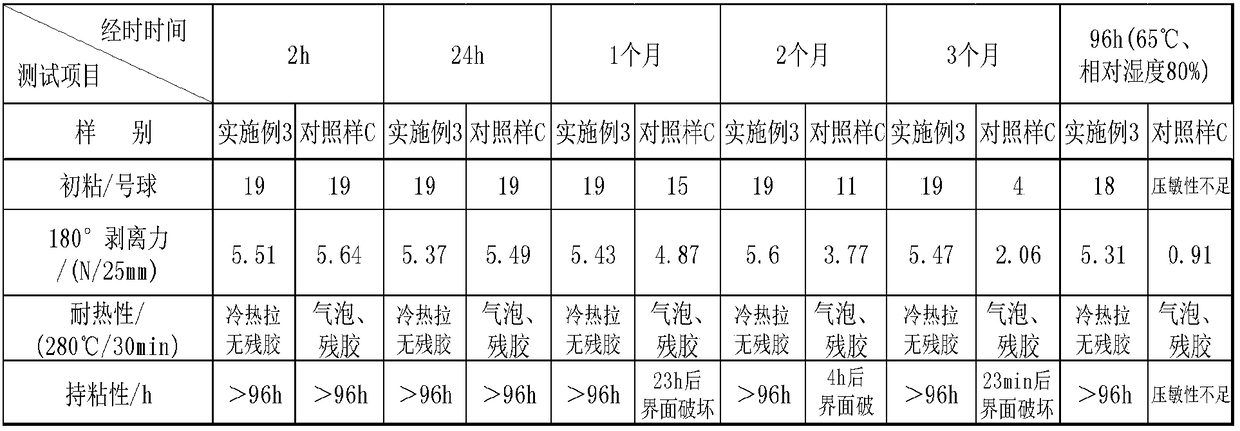A method for improving the stability of silicone pressure-sensitive adhesives for protective films
A silicon pressure-sensitive adhesive and protective film technology, applied in the direction of adhesives, etc., can solve problems such as viscosity and other performance changes gradually, cannot meet the use requirements, and use performance is unstable, so as to achieve good use performance, convenience and practicality Performance, stable temperature resistance and storage performance
- Summary
- Abstract
- Description
- Claims
- Application Information
AI Technical Summary
Problems solved by technology
Method used
Image
Examples
Embodiment 1
[0032] Step 1) polycondensation reaction
[0033]Put 100Kg of toluene and 200Kg of xylene into the reactor, add 500g of diethylamine, stir evenly, then add 225Kg of hydroxyl-terminated polydimethylsiloxane with a viscosity of about 8000mPa.s and 275Kg of nM / nQ MQ resin with Mn of 0.75 about 5000g / mol, Mw about 18000g / mol and hydroxyl content of about 3% was stirred for 30min under nitrogen protection, then heated to about 135°C and kept under reflux for a stable reaction of about 210min. During the reaction The generated water is continuously discharged through the Dean-Stark trap or U-shaped pipe trap;
[0034] Step 2) Dehydration and Residual Hydroxyl Removal
[0035] The temperature in the reactor is reduced to about 45°C, and 10Kg of trimethylacetoxysilane (Me 3 SiOAc), stirring and reacting for more than 90min, then heating up to about 70°C, and starting to deactivate the polycondensation catalyst;
[0036] Step 3) Catalyst deactivation treatment
[0037] Keep the adh...
Embodiment 2
[0049] Step 1) polycondensation reaction
[0050] Put 100Kg of toluene and 200Kg of xylene into the reactor, add 500g of triethylamine, stir evenly, then add 200Kg of hydroxyl-terminated polydimethylsiloxane with a viscosity of about 7000mPa.s and 300Kg of nM / nQ MQ resin with Mn of 0.80 about 5000g / mol, Mw about 18000g / mol and hydroxyl content of about 3% was stirred for 30min under nitrogen protection, then heated to about 135°C and kept under reflux for a stable reaction of about 210min. During the reaction The generated water is continuously discharged through the Dean-Stark trap or U-shaped pipe trap;
[0051] Step 2) remove water and remove hydroxyl
[0052] Keep the temperature in the reactor at 40°C to 45°C, and add 10.5Kg of trivinylacetoxysilane (Vi 3 SiOAc), stirring for more than 90min, then heating up to about 70°C, and starting to deactivate the polycondensation catalyst;
[0053] Step 3) Catalyst deactivation treatment
[0054] Keep the adhesive reaction syst...
Embodiment 3
[0065] Embodiment 3 (improves the stability of finished product silicone pressure-sensitive adhesive)
[0066] Step 1) remove water and remove hydroxyl
[0067] Place 1000Kg of a domestically produced silicone pressure-sensitive adhesive in a reactor, and add 12.0Kg of triethylacetoxysilane (Et 3 SiOAc), then be warming up to about 40 ℃ and continue to stir more than 90min;
[0068] Step 2) Catalyst deactivation treatment
[0069] Keep the adhesive reaction system at about 70°C under a nitrogen reaction atmosphere, add 5% HCl ether solution containing 1.5Kg HCl to the reaction kettle under stirring, and continue stirring for 90 minutes;
[0070] Step 3) Removal of Small Molecules
[0071] After step 2) is completed, raise the temperature of the reactor to 110°C or above, and then remove the small molecular substances in the adhesive reaction system from the reaction material under a vacuum condition of not less than -0.09MPa. less than 90min;
[0072] Step 4) Neutralize t...
PUM
| Property | Measurement | Unit |
|---|---|---|
| viscosity | aaaaa | aaaaa |
| viscosity | aaaaa | aaaaa |
Abstract
Description
Claims
Application Information
 Login to View More
Login to View More - R&D
- Intellectual Property
- Life Sciences
- Materials
- Tech Scout
- Unparalleled Data Quality
- Higher Quality Content
- 60% Fewer Hallucinations
Browse by: Latest US Patents, China's latest patents, Technical Efficacy Thesaurus, Application Domain, Technology Topic, Popular Technical Reports.
© 2025 PatSnap. All rights reserved.Legal|Privacy policy|Modern Slavery Act Transparency Statement|Sitemap|About US| Contact US: help@patsnap.com



